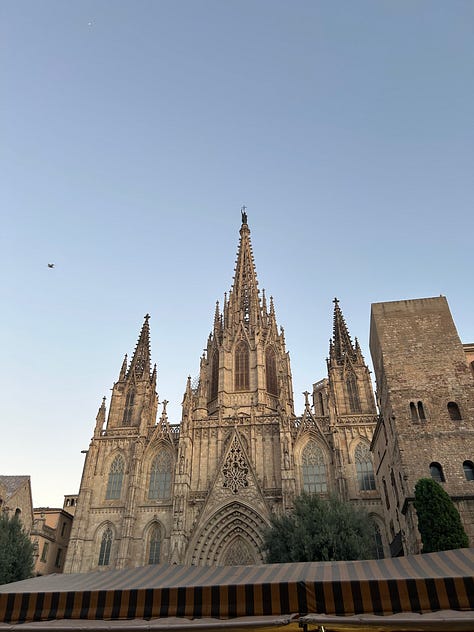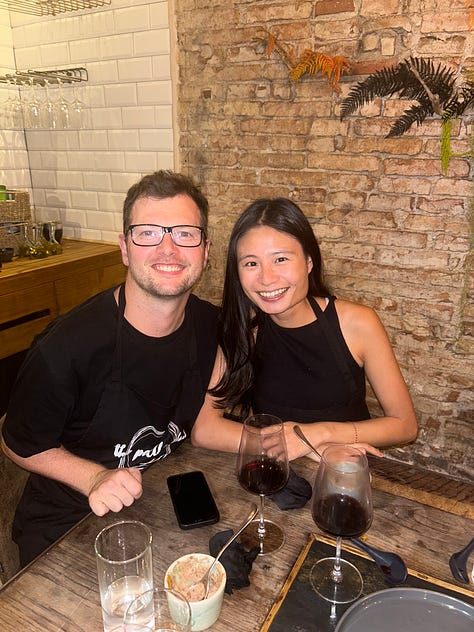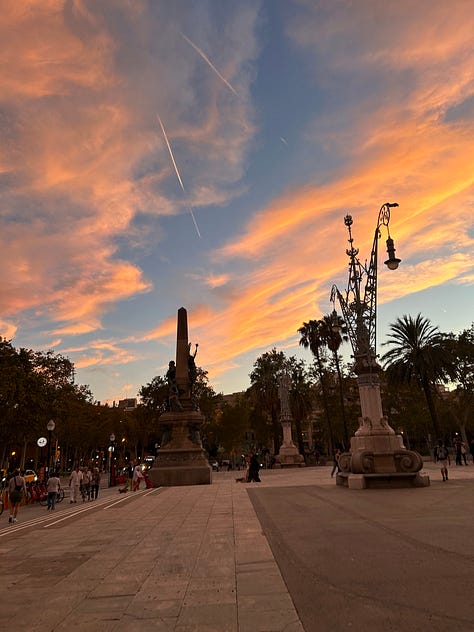On Moving Slowly
How Spain changed the way I work and live
“How long are you here for?” The Spanish Customs officer asked as he thumbed through my passport.
“6 weeks,” I replied, watching his eyebrows shoot up his forehead.
It’s a reaction Ben and I had become familiar with.
When we told people we were packing up our lives in Australia to live and travel abroad for 18 months, most of them blinked in surprise. Some even recoiled a little.
Especially when we said we were starting off with two months in Bali, then six weeks in Spain.
“What will you do there for that long?” was the usual follow-up.
It seemed crazy to spend such a huge chunk of time in just a couple of places, especially in Europe, where you can technically eat croissants in Paris for breakfast and dine in Rome on the same day.
I used to be one of those people.
While on a study exchange in 2017, I treated each European city like stops on a train line, trying to hit as many as I could.
One week, I spent three days in Rome, 48 hours in Florence, a half-day in Pisa just for the photo opp, then sprinted off to Barcelona.
Each morning, I’d stumble out of a hostel bed—usually jolted awake by an alarm, someone snoring, or someone coming home from a party.
Then, I’d hit a free walking tour and visit attraction after attraction before scrambling onto the next bus or plane.
I can show you hundreds of photos of me standing in front of monuments, churches, and museums to prove I did it! I ticked it off my list!
(And thankfully I have them archived in Google Photos, because it was all a blur.)
But it felt like I was only scratching the surface of each city.
Seven years on, our rhythm in Spain couldn’t be more different.
For one thing, we got to fully unpack our suitcases.
With four weeks in Barcelona and two in Malaga, we have the space and time to let our days unfold gently.
There were no alarms. No frantic scrambling.
Our flat was smack bang in Barcelona’s Gothic Quarter, so we’d spend the morning wandering down cobblestone alleys, past gothic spires, and into cute cafes.
I’d practice speaking Spanish with the local barista (“Un café con leche, para llevar, por favor”), before returning home to sink my teeth into a sales page for my clients while Ben worked on his Salesforce certification.
Some afternoons, we’d have time to laze on the beach to soak up Spain’s glorious sun, which was still warm even in October and early November. Or hop trains to visit the neighbouring costal towns.
Evenings were for slow supermarket runs.
In Melbourne, grocery shopping always felt like a chore in an already jam-packed week. Ben and I would bulk-buy everything in one go and have it delivered to save time because we were always rushing. Work deadlines, life admin, meal prep, self-imposed pressure—it all piled up, and there was never enough time.
But, in Spain, we took pleasure in wandering to the supermarket each night and picking up only what we needed for dinner.
Sometimes, we’d let a waiter tempt us inside in his bar for a glass of Tinto de Verano before heading home.
Other times, we’d keep it simple: a quiet dinner sitting on the couch, binge-watching Only Murders in the Building.
I’ll admit: I didn’t love the slower pace at first.
I was itching for things to tick off the list.
I’d scroll through Instagram, watching people post about their packed itineraries, thinking, Am I wasting this time? Should I be doing more?
But over the weeks, something shifted.
I started noticing how much calmer I felt without the constant rush. How unhurried conversations with strangers made the day feel richer. How evenings stretched out when they weren’t stuffed with tasks and to-dos.
That difference—the feeling of having time—is what struck me the most.
We still had a list of attractions to see and do. But instead of clinging to it, we let the mood decide.
I get that this slower rhythm of travel isn’t accessible to everyone - and it didn’t use to be for us, either.
If you’ve only got four weeks of annual leave and it takes 17+ hours to fly from Australia to Europe, zipping through landmarks makes sense—you want to squeeze in as many landmarks as possible.
But the opportunity for slow travel is why I chose the chaos of running my own business.
It’s why I tolerate the rollercoaster highs and lows of self-employment: because it gives me both the funds and the freedom to “slow-mad” across Europe.
Granted, we won’t be able to spend weeks in every European city (thanks, Schengen rules) —but where we can, we savour. And it’s a privilege I don’t take lightly.
It got me thinking about how often I find myself racing - in life and business.
Since the pandemic, I’ve been in a constant rush—chasing deadlines, stacking milestones, trying to hit the next big number: $1k, $5k, 5-figure months, 6-figures, more. Always thinking, How can I get there faster?
And when it didn’t happen fast enough, I’d feel crushed.
Especially when I’d watch other people achieve things at breakneck speed—hitting goals I’d barely dared to dream of, while I was still stuck crawling in the slow lane. It was a race I was always losing.
But Spain reminded me that slowing down isn’t failure. It’s space.
Space to breathe.
To let ideas simmer instead of forcing them to boil over.
To realise that the same pressure I used to cram into my travels—trying to tick as many cities off fast—is the same self-imposed pressure I’ve been cramming into my business.
And just like before, rushing meant I was too focused on what was next to enjoy what was right in front of me.
Because as it turns out…
The best parts of Spain wasn’t the fact we’d ticked off every attraction TikTok told us to visit -
They were the unplanned moments I would’ve missed if I’d kept rushing. Like wandering into a café for a quick coffee and staying for an hour-long chat with the barista. Or turning a simple grocery run into a long, lazy dinner with no agenda except to enjoy the evening.
And the best parts of business weren’t the milestones that felt good for one second then empty the next.
They were what happened when I finally slowed down—like having the space to create a new product that’ll better serve my audience, attending an event where the conversations sparked new ideas, or stepping away from constant client work to write essays (like this one) that reminded me why I started in the first place.
And with that, I’m learning:
Maybe it’s not about rushing to tick off every box or chasing the next big milestone.
Maybe it’s about slowing down enough to notice the moments that actually make life feel full. The kind you can’t plan for—the surprise conversations, the quiet evenings, the messy in-betweens.
Because when you stop trying to race to the next thing, you realise: where you are—and what you’ve done—is already enough.







